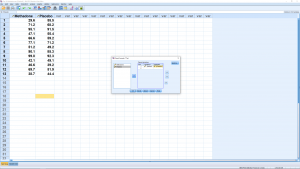10. Comparing Two Population Means
10.10 SPSS Lesson 7: Paired Sample t-Test
To follow along, load in the Data Set “Methadone.sav”:

As set up, the file has two dependent variables. This “within subjects” dataset is fundamentally multivariate. When we did the paired ![]() -test by hand we converted the multivariate data to univariate data by taking differences. SPSS will do the differences behind the scene and you won’t actually see them. Run the
-test by hand we converted the multivariate data to univariate data by taking differences. SPSS will do the differences behind the scene and you won’t actually see them. Run the ![]() -test by picking Analyze
-test by picking Analyze ![]() Compare Means
Compare Means ![]() Paired -Samples T-Test:
Paired -Samples T-Test:

Move the two variables into Pair 1 and hit OK (Options again allows you to specify a confidence intervals percentage):

The output is:

The first two tables are descriptive statistics. The last table gives the stuff we want: ![]() ,
, ![]() , the confidence interval
, the confidence interval
(10.11) ![]()
![]() ,
, ![]() and
and ![]() for the two-tailed hypotheses pair
for the two-tailed hypotheses pair
![]()
(10.12) ![]()
The very low ![]() -value (0 in this case) and the absence of 0 in the confidence interval guide us to reject
-value (0 in this case) and the absence of 0 in the confidence interval guide us to reject ![]() , the differences are significantly different from zero.
, the differences are significantly different from zero.
The standardized effect size and strength of association for the paired ![]() -test are
-test are
(10.13) ![]()
and
(10.14) ![]()
respectively.

